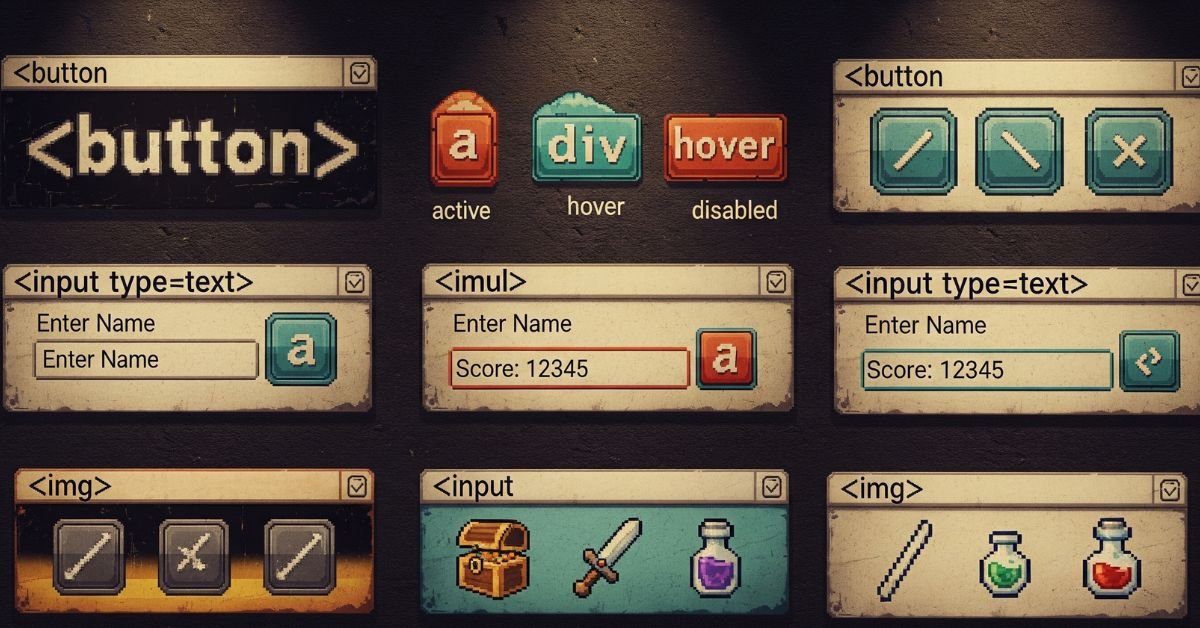When you start making web games, one of the most awesome things is making them look real. Understanding how to add textures in HTML games is a basic ability for any game developer. Textures are what make simple shapes into complex objects that actually look and even feel like they are alive. Take a green flat square, for instance. With a grass texture, it’s a field. A regular cube is a brick wall when you put the right pattern on it. This tutorial is gonna guide you through how to add, organize, and optimize textures in steps. It will keep it simple but detailed enough so you can apply it to your own projects.
Understanding Textures in Game Development
Textures are images applied to objects to give them color, depth, and detail. They can make a game environment look natural and realistic. Without textures, game objects look flat and boring. With textures, even a basic HTML game can look professional.
In HTML games, you often deal with three types of textures. A sprite is a single image that represents a character or object. A background texture can be repeated to cover large areas like skies or walls. A sprite sheet is a collection of textures stored in one file to improve performance. All of these help to reduce rendering time and keep the game smooth.
You will like : How Generative AI will Transform Software Development by 2025
Setting Up the HTML Game Environment
To start, you need a proper setup. The most common tools are HTML5 Canvas, WebGL, and libraries like Three.js and Babylon.js. Each has its own strength. Canvas is good for 2D games. WebGL is used for 3D graphics. Three.js and Babylon.js are JavaScript frameworks that make WebGL easier.
It is important to also structure your project well. A typical setup includes an index.html file, a main.js file for scripts, and a folder called assets where you keep textures and images. Organizing files from the beginning saves time later and avoids confusion when the game grows.
Loading and Managing Texture Files
Loading textures the right way is important. The common file types are PNG, JPG, and WebP. PNG keeps transparency, JPG is lighter, and WebP gives better compression for web games.
Here is a table comparing the three formats used in HTML games:
| Format | Best Use | Strength | Weakness |
| PNG | Transparent textures like sprites | High quality, supports alpha | Larger file size |
| JPG | Backgrounds and photos | Small file size | No transparency, lossy |
| WebP | Modern textures for web | High compression, good quality | Not supported by older browsers |
To manage textures, developers often preload images before the game starts. Preloading avoids delays when the player enters a new level. Another option is lazy loading, which loads textures only when needed. Using a sprite atlas combines many small textures into one large file. This reduces the number of requests to the browser, which makes games load faster.
Applying Textures to Game Objects
Applying textures is the real step where objects come to life. In Canvas, you can draw textures by loading an image and painting it on shapes. In WebGL, textures are mapped onto 3D objects through shaders. These shaders define how light and surfaces interact, making the object look realistic.
For 3D libraries like Three.js, applying textures is very simple. You just load the texture using the built-in loader and attach it to a material. That material is then wrapped around the object. With this, a plain cube becomes a realistic dice, or a wall looks like it is made of stone. Texture wrapping and scaling let you stretch, repeat, or shrink textures as needed.
Advanced Texture Techniques with WebGL
WebGL allows you to push textures beyond simple images. One important method is UV mapping, which defines how the image is placed on the object. Without UV mapping, textures often look distorted.
Another advanced method is adding extra maps. Normal maps add depth by faking bumps and dents. Bump maps create shadows and highlights to give a sense of texture. Developers can also use dynamic textures, such as videos or procedural patterns. By mixing these techniques with custom shaders, HTML games can reach console-level quality.
Read More : What is a RESTful Web Service
Optimizing Texture Performance
Performance is a big issue in web games because browsers have limited memory. Large textures can slow down the game or even crash it. To avoid this, you should keep textures small but sharp.
Compression is very useful here. Libraries can compress textures into formats like DDS or Basis to save space. Developers also use sprite atlases to combine textures. This reduces draw calls, which improves rendering speed. The table below shows methods of optimization for textures in HTML games:
| Technique | How It Works | Benefit |
| Texture Compression | Reduce texture size | Faster loading |
| Sprite Atlas | Combine multiple textures | Fewer draw calls |
| Mipmapping | Store multiple sizes of texture | Better scaling performance |
| Lazy Loading | Load when needed | Save memory |
Debugging and Fixing Common Issues
Sometimes textures don’t work as expected. A very common issue is blurry or stretched textures. This happens when the wrong resolution is used. Another issue is CORS errors. If the image is hosted on a different domain without permission, the texture will not load.
Other common problems are flickering textures and alignment errors. Flickering is usually caused by wrong mipmapping. Alignment issues happen when UV coordinates are not set correctly. Knowing these fixes helps you save hours of debugging time.
Adding Textures to a Simple HTML Game
Let’s look at a real example. Imagine a simple 2D platformer game. You have a green rectangle for the ground. It looks boring. You load a grass texture using Canvas and apply it to that rectangle. Suddenly, it feels like a real game environment.
Now consider a 3D case. In WebGL with Three.js, you create a cube. Without a texture, it is just gray. You load a brick wall texture and wrap it around. The cube now looks like a piece of a building. This shows how How to Add Textures in HTML Games can change the entire look of a game.
Future of Textures in HTML Games
The world of HTML games is growing fast. In the future, developers will use new formats like Basis Universal and KTX2 for even smaller, high-quality textures. Procedural textures will also rise. These are generated with code instead of stored images. They save memory and create infinite variations.
Another trend is PBR (Physically Based Rendering). This method simulates how light interacts with surfaces in real life. With PBR textures, HTML games can look close to console or PC quality. Mobile browsers are also improving, making it possible to use high-resolution textures without lag.
Extended Case Study A Mini HTML Racing Game
To see how textures change everything, imagine a racing game built in Canvas. At first, the road is just a gray rectangle, and the car is a plain box. It works, but it’s boring. Now you add a road texture for the track, a tire texture for the wheels, and a car skin texture for the body. Suddenly, the player feels like they are driving on asphalt with real details.
In a 3D racing game using Three.js, the same principle applies. Without textures, the car is just a model. With textures, the body has paint, the lights shine, and the wheels look real. Even the skybox (the world around the track) uses a texture. This creates immersion, where the player forgets it’s just a browser game.
Procedural Textures in HTML Games
Not all textures have to be created in Photoshop or downloaded. Developers often use procedural textures, which are generated with math formulas and code. For example, instead of loading a “wood” image, you can generate random lines and colors that look like wood grain. The advantage is that procedural textures don’t require image files, so the game loads faster and uses less memory.
FAQ’’S
Can I use GIFs or videos as textures in HTML games?
Yes, you can. Videos and animated GIFs can be used as textures. However, they may affect performance on weaker devices.
What’s the best image format for game textures?
PNG is best for sprites and transparency, JPG works for photos, and WebP is ideal for modern web use.
Do I need WebGL to add textures in games?
Not always. Canvas can handle simple textures, but for advanced 3D textures, WebGL or a library is needed.
How can I preload textures for faster loading times?
You can use JavaScript functions to load all textures before the game starts. This avoids delays during gameplay.
How do I handle textures on mobile browsers?
Keep textures small, use compression, and test on multiple devices. Mobile hardware is limited compared to desktop.
Conclusion
Adding textures is what makes games beautiful and real. With HTML games, you can use Canvas for 2D, WebGL for 3D, and libraries like Three.js for advanced work. Always choose the right image format, manage files smartly, and optimize for performance. How to Add Textures in HTML Games is not only about coding but also about creativity. When done right, it changes flat objects into immersive experiences.




